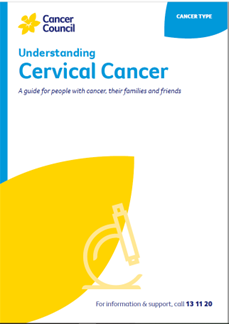- Home
- Cervical cancer
- Diagnosis
- Tests
- Colposcopy and biopsy
Colposcopy and biopsy
A colposcopy is a way of looking closely at the cervix and vagina to see if there are any abnormal or changed cells. It is done by a colposcopist, who is usually a gynaecologist, gynaecological oncologist or, in some clinics, a nurse practitioner.
Learn more about:
- How long does it take?
- How is it done?
- What happens after the colposcopy and biopsy are done?
- Side effects of a colposcopy with biopsy
How long does it take?
A colposcopy takes only about 10–15 minutes. You will usually be advised not to have sex or put anything in your vagina (e.g. tampons) for 24 hours before the procedure.
How is it done?
A colposcopy is done with an instrument called a colposcope, which is a microscope with a light. The colposcope is placed near your genital area (vulva) but does not enter your body. You will lie on your back in an examination chair with your knees up and apart.
The colposcopist will use a speculum to spread the walls of your vagina apart, and will usually apply a vinegar-like liquid and iodine to your cervix and vagina. This makes it easier to see any abnormal cells through the colposcope. You may feel a mild stinging or burning sensation, and you may have a brown discharge from the vagina after the procedure.
If the colposcopist sees any abnormal-looking areas during the colposcopy, they may take a tissue sample (biopsy) from the surface of the cervix. You may feel some pain for a short time while the tissue sample is taken.
What happens after the colposcopy and biopsy are done?
You will be able to go home once the colposcopy and biopsy are done. The tissue sample is sent to a laboratory, and a pathologist will examine the cells under a microscope to see if they are abnormal (precancer or cancer). The results are usually available in about one week.
Side effects of a colposcopy with biopsy
After the procedure, it is common to have cramping that feels similar to pain you may have with your period (menstrual pain). This may last a short time and can be relieved with mild pain medicines such as paracetamol or non-steroidal anti-inflammatory drugs. You may also have some light bleeding or other vaginal discharge for up to a week.
To give the cervix time to heal and to reduce the risk of infection, your colposcopist may advise you not to have sexual intercourse or use tampons for a certain amount of time after the procedure.
Learn more about colposcopies.
My doctor said that because I had regular cervical screening tests, the cancer was picked up while it was small.
Karen
→ READ MORE: Treating precancerous abnormalities
Podcast: Tests and Cancer
Listen to more of our podcast for people affected by cancer
More resources
Prof Martin Oehler, Director of Gynaecological Oncology, Royal Adelaide Hospital, and Clinical Professor, University of Adelaide, SA; Dawn Bedwell, 13 11 20 Consultant, Cancer Council QLD; Gemma Busuttil, Radiation Therapist, Crown Princess Mary Cancer Centre, Westmead Hospital, NSW; Dr Antonia Jones, Gynaecological Oncologist, The Royal Women’s Hospital and Mercy Hospital for Women, VIC; Angela Keating, Senior Psychologist, Royal Hospital for Women, NSW; Anne Mellon, Clinical Nurse Consultant – Gynaecological Oncology, Hunter New England Centre for Gynaecological Cancer, NSW; Dr Inger Olesen, Medical Oncologist, Andrew Love Cancer Centre, Barwon Health, Geelong, VIC; Dr Serena Sia, Radiation Oncologist, Fiona Stanley Hospital and King Edward Memorial Hospital, WA; A/Prof Megan Smith, Co-lead, Cervical Cancer and HPV Stream, The Daffodil Centre, Cancer Council NSW and The University of Sydney, NSW; Emily Stevens, Gynaecology Oncology Nurse Coordinator, Southern Adelaide Local Health Network, Flinders Medical Centre, SA; Melissa Whalen, Consumer.
View the Cancer Council NSW editorial policy.
View all publications or call 13 11 20 for free printed copies.

